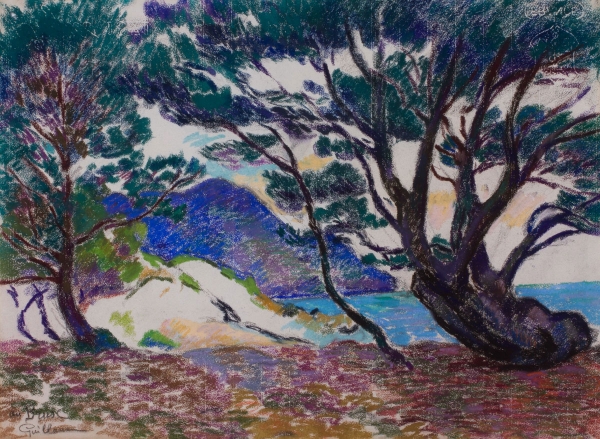GUILLAUMIN, Maritime Pines, Creek in Le Brusc

Armand GUILLAUMIN (1841-1927)
Maritime Pines, Creek in Le Brusc
ca. 1911
pastel on paper
48 x 62 cm
© MuMa Le Havre / Charles Maslard
Maritime Pines, Creek in Le Brusc
ca. 1911
pastel on paper
48 x 62 cm
© MuMa Le Havre / Charles Maslard
HD image
In 1891, Guillaumin won a considerable sum in a state lottery and was able to leave his job with the Orléans railway in order to travel. "Chic, I will be able to paint the sea," he wrote. The artist discovered the Mediterranean coast in 1887. The first painting he produced was a View of the Rocks at Agay. Provence would become an annual destination for the painter to spend the late winter. A few years after he first discovered the south, Guillaumin wrote to a friend on March 12, 1911: "I love working on red rocks and twisting trees. I have already used five tubes of vermilion and other reds..."
In the spring of 1911, Guillaumin changed his itinerary on the Riviera and decided to go to Le Brusc, near Toulon, before his annual visit to Agay and Le Trayas. The rocks of Le Brusc do not have all the bright shades of red and the escarpments wrought by the waves that one can find at Agay. The painter chose to portray the maritime pine forest with the Mont Salvat towering in the background. In such a way, he could play with contrasts between the warm colours of the reddish soil from which the pine trees grow and the cool colours of the blue sea stretched out peacefully beneath a sky of soft pink clouds. Guillaumin tinged the shadows with purple and blue following Chevreul's theories on colour. He worked on the contrasts between the areas of saturated shadows and the areas of full light with the white of the paper left showing through, thus reinforcing the overall luminosity.
In the spring of 1911, Guillaumin changed his itinerary on the Riviera and decided to go to Le Brusc, near Toulon, before his annual visit to Agay and Le Trayas. The rocks of Le Brusc do not have all the bright shades of red and the escarpments wrought by the waves that one can find at Agay. The painter chose to portray the maritime pine forest with the Mont Salvat towering in the background. In such a way, he could play with contrasts between the warm colours of the reddish soil from which the pine trees grow and the cool colours of the blue sea stretched out peacefully beneath a sky of soft pink clouds. Guillaumin tinged the shadows with purple and blue following Chevreul's theories on colour. He worked on the contrasts between the areas of saturated shadows and the areas of full light with the white of the paper left showing through, thus reinforcing the overall luminosity.

















